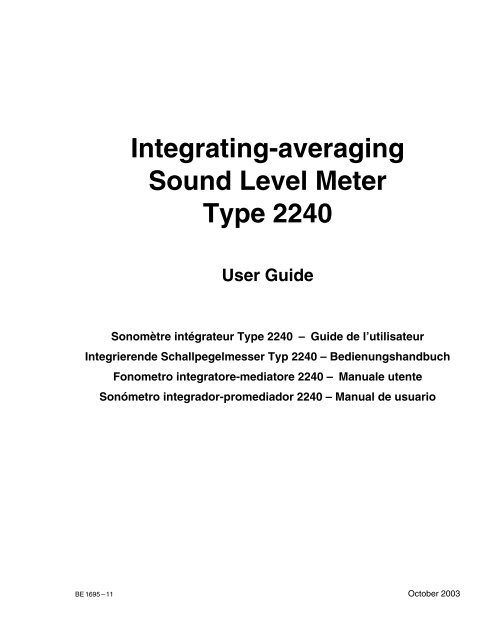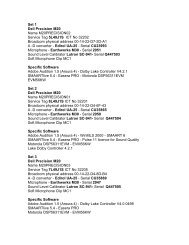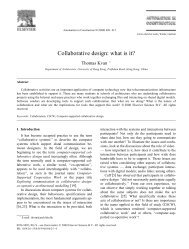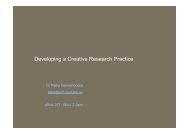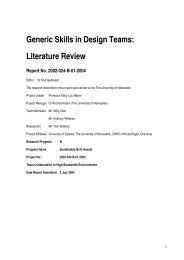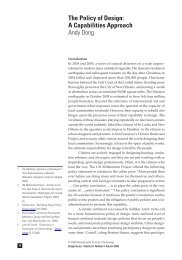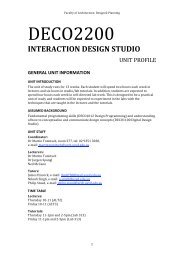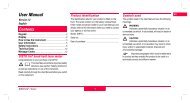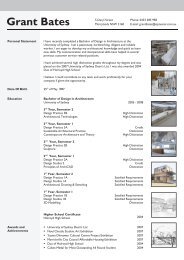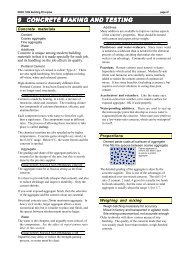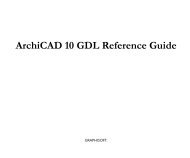bruel & kjaer 2240 sound level meter
bruel & kjaer 2240 sound level meter
bruel & kjaer 2240 sound level meter
Create successful ePaper yourself
Turn your PDF publications into a flip-book with our unique Google optimized e-Paper software.
Integrating-averaging<br />
Sound Level Meter<br />
Type <strong>2240</strong><br />
User Guide<br />
Sonomètre intégrateur Type <strong>2240</strong> – Guide de l’utilisateur<br />
Integrierende Schallpegelmesser Typ <strong>2240</strong> – Bedienungshandbuch<br />
Fonometro integratore-mediatore <strong>2240</strong> – Manuale utente<br />
Sonómetro integrador-promediador <strong>2240</strong> – Manual de usuario<br />
BE 1695 – 11 October 2003
Copyright © 2003, Brüel & Kjær Sound & Vibration Measurement A/S<br />
All rights reserved. No part of this publication may be reproduced or distributed in any<br />
form, or by any means, without prior written consent from Brüel & Kjær Sound & Vibration<br />
Measurement A/S, Nærum, Denmark
Contents<br />
Part 1<br />
English.............................................................................................................................. 1<br />
Chapter 1: Introduction ........................................................................................................ 3<br />
Chapter 2: Getting Started ................................................................................................... 7<br />
Chapter 3: Making a Measurement.................................................................................... 15<br />
Chapter 4: Basic Operation................................................................................................ 17<br />
Chapter 5: Practical Guidelines ......................................................................................... 25<br />
Chapter 6: Maintenance and Service................................................................................. 29<br />
Chapter 7: Specifications ................................................................................................... 31<br />
Chapter 8: Glossary ........................................................................................................... 35<br />
Part 2<br />
Français .......................................................................................................................... 41<br />
Chapitre 1: Généralités ...................................................................................................... 43<br />
Chapitre 2: Se familiariser avec l’appareil.......................................................................... 47<br />
Chapitre 3: Mesurer ........................................................................................................... 57<br />
Chapitre 4: Fonctions principales....................................................................................... 59<br />
Chapitre 5: Conseils de manipulation ................................................................................ 69<br />
Chapitre 6: Entretien et réparation..................................................................................... 73<br />
Chapitre 7: Spécifications .................................................................................................. 75<br />
Chapitre 8: Glossaire ......................................................................................................... 79<br />
Teil 3<br />
Deutsch........................................................................................................................... 85<br />
Kapitel 1: Einführung.......................................................................................................... 87<br />
Kapitel 2: Erste Schritte ..................................................................................................... 91<br />
Kapitel 3: Durchführung von Messungen......................................................................... 101<br />
Kapitel 4: Wichtige Bedienfunktionen .............................................................................. 103<br />
Kapitel 5: Praktische Hinweise......................................................................................... 113<br />
Kapitel 6: Wartung und Service ....................................................................................... 117<br />
Kapitel 7: Technische Daten ............................................................................................ 119<br />
Kapitel 8: Glossar............................................................................................................. 123<br />
Parte 4<br />
Italiano .......................................................................................................................... 129<br />
Capitolo 1: Introduzione ................................................................................................... 131<br />
Capitolo 2: Preparazione ................................................................................................. 135<br />
Capitolo 3: Esecuzione di una misura.............................................................................. 145<br />
Capitolo 4: Funzionamento di base ................................................................................. 147<br />
Capitolo 5: Linee guida .................................................................................................... 155<br />
Capitolo 6: Assistenza e manutenzione........................................................................... 159<br />
Capitolo 7: Dati tecnici ..................................................................................................... 161<br />
Capitolo 8: Glossario........................................................................................................ 165
Part 5<br />
Español ......................................................................................................................... 171<br />
Capítulo 1: Introducción ................................................................................................... 173<br />
Capítulo 2: Puesta en marcha ......................................................................................... 177<br />
Capítulo 3: Cómo hacer una medida ............................................................................... 187<br />
Capítulo 4: Operaciones Básicas..................................................................................... 189<br />
Capítulo 5: Practical Guidelines....................................................................................... 199<br />
Capítulo 6: Mantenimiento y Servicio .............................................................................. 203<br />
Capítulo 7: Especificaciones............................................................................................ 205<br />
Capítulo 8: Glosario ......................................................................................................... 209
1<br />
Part 1<br />
English
3<br />
Chapter 1<br />
Introduction<br />
Welcome ................................................................................................................................... 4<br />
Summary of Contents................................................................................................................ 4<br />
Conventions Used in this Guide ...................................................................................... 4<br />
About Type <strong>2240</strong> ....................................................................................................................... 5<br />
Uses and Features .......................................................................................................... 5
4<br />
Integrating-averaging Sound Level Meter Type <strong>2240</strong> – User Guide<br />
Welcome<br />
This user guide introduces you to Type <strong>2240</strong> Integrating-averaging Sound Level Meter, how the<br />
instrument works, which para<strong>meter</strong>s you can measure, and how the instrument should be operated.<br />
In addition, some practical hints and guidelines are provided for, including all relevant<br />
technical specifications. Finally, a glossary is added to help with specific terminology found in<br />
this guide.<br />
Summary of Contents<br />
• Chapter 1 – Introduction: provides a general overview of the user guide and describes<br />
Sound Level Meter Type <strong>2240</strong>’s uses and features<br />
• Chapter 2 – Getting Started: provides basic introductory information to <strong>sound</strong> <strong>level</strong> <strong>meter</strong>s<br />
and your instrument, including: general terminology, description of instrument parts, display<br />
and key definitions, and battery installation<br />
• Chapter 3 – Making a Measurement: step-by-step instructions on how to take a measurement<br />
with Type <strong>2240</strong><br />
• Chapter 4 – Basic Operation: contains information and appropriate procedures on how to<br />
use Type <strong>2240</strong>, including calibration, start-up, reading and key operation guides<br />
• Chapter 5 – Practical Guidelines: gives tips on how to take a successful <strong>sound</strong> <strong>level</strong> measurement,<br />
and what conditions and actions to avoid<br />
• Chapter 6 – Maintenance and Service: provides care, cleaning and storage instructions as<br />
well as information on where to go for service of your instrument<br />
• Chapter 7 – Specifications: a comprehensive listing of technical specifications of Type <strong>2240</strong><br />
• Chapter 8 – Glossary: a quick list of terms used in this guide and their definitions<br />
Conventions Used in this Guide<br />
Instructions and descriptions that refer to Type <strong>2240</strong> instrument keys are shown with the key<br />
icons as seen on the instrument. See Chapter 2 for a complete list of of key icons and their<br />
functions.<br />
Instructions and descriptions that refer to Type <strong>2240</strong> instrument display text are indicated using<br />
Courier type face. For example, “Press until L Aeq is visible on the screen”.<br />
Terms that are defined in the Glossary (Chapter 8), are highlighted in italic bold.
PART 1<br />
English 5<br />
About Type <strong>2240</strong><br />
Uses and Features<br />
Type <strong>2240</strong> is a Class 1 integrating-averaging <strong>sound</strong> <strong>level</strong> <strong>meter</strong> that measures time-average<br />
<strong>sound</strong> <strong>level</strong> as defined in the IEC 61672-1 standard. Its uses and features include:<br />
• Simple <strong>sound</strong> <strong>level</strong> checks<br />
• Control of noise <strong>level</strong>s in the workplace<br />
• Complaint investigation<br />
• Quick and easy to use<br />
• Conforms with IEC 61672-1 Class 1, IEC 60651 and 60804 Type 1, ANSI S 1.4–1983 Type S1<br />
and ANSI S 1.43–1997 Type 1<br />
• Simultaneous RMS and Peak measurements (with independent frequency weightings)<br />
• Measures L AF , L Aeq , L AFmax and L Cpeak<br />
• No para<strong>meter</strong> configuration needed, the instrument is ready to measure from the start<br />
• Large LCD display screen for easy reading<br />
• Quasi-analogue bar graph shows current <strong>sound</strong> pressure <strong>level</strong><br />
• Under-range and overload indicators
6<br />
Integrating-averaging Sound Level Meter Type <strong>2240</strong> – User Guide
7<br />
Chapter 2<br />
Getting Started<br />
What is a Sound Level Meter? .................................................................................................. 8<br />
Description of Type <strong>2240</strong> Sound Level Meter ........................................................................... 8<br />
Sound Level Para<strong>meter</strong>s ................................................................................................. 8<br />
Instrument Components ................................................................................................ 10<br />
Installing Batteries ................................................................................................................... 13
8<br />
Integrating-averaging Sound Level Meter Type <strong>2240</strong> – User Guide<br />
Type <strong>2240</strong> is a high performance, Class 1, integrating-averaging <strong>sound</strong> <strong>level</strong> <strong>meter</strong> with an<br />
easy-to-use interface for quick and simple measurements. This chapter details the instrument’s<br />
components and basic <strong>sound</strong> <strong>level</strong> para<strong>meter</strong>s involved in measuring. With this information you<br />
should be able to immediately start using your <strong>sound</strong> <strong>level</strong> <strong>meter</strong>. However, it is recommended<br />
that you read the entire guide before using your Type <strong>2240</strong> in order to achieve the best results<br />
from your instrument.<br />
What is a Sound Level Meter?<br />
A <strong>sound</strong> <strong>level</strong> <strong>meter</strong> is an instrument that is designed to measure <strong>sound</strong> <strong>level</strong>s in a standardised<br />
way. A <strong>sound</strong> <strong>level</strong> <strong>meter</strong> comprises a microphone, a main processor and a read-out unit. The<br />
microphone converts <strong>sound</strong> to an equivalent electric signal, which is processed by the instrument.<br />
Processing includes applying frequency and time weightings to the signal as specified by<br />
international standards, such as IEC 61672-1 to which Type <strong>2240</strong> conforms.<br />
Frequency weighting adjusts how the <strong>sound</strong> <strong>level</strong> <strong>meter</strong> responds to different <strong>sound</strong> frequencies.<br />
This is necessary because the human ear's sensitivity to <strong>sound</strong> varies according to the<br />
<strong>sound</strong>’s frequency. The most common frequency weighting in use is A-weighting, which adjusts<br />
a signal in a way that best resembles the human ear's response at medium-range <strong>level</strong>s. It is the<br />
weighting required for nearly all environmental and workplace noise measurements, and is<br />
specified in international and national standards and guidelines. All of Type <strong>2240</strong>’s measurement<br />
para<strong>meter</strong>s apply A-weighting, except for the measurement of peak <strong>level</strong>s where the ‘C’<br />
frequency weighting is applied. In this case, C-weighting is used to take into account the energy<br />
present at low frequencies even if they are not particularly annoying.<br />
Time weighting specifies how the <strong>sound</strong> <strong>level</strong> <strong>meter</strong> reacts to changes in <strong>sound</strong> pressure. It is<br />
an exponential averaging of the fluctuating signal, providing an easy-to-read value. Type <strong>2240</strong><br />
always applies the Fast, or ‘F’ time weighting, which is the required weighting according to the<br />
vast majority of international and national standards and guidelines.<br />
Once the signal is processed through the weighting filters, the resulting <strong>sound</strong> pressure <strong>level</strong> is<br />
displayed in decibels (dB) on the instrument's display. In Type <strong>2240</strong>, the <strong>sound</strong> pressure <strong>level</strong><br />
values are updated once per second.<br />
Description of Type <strong>2240</strong> Sound Level Meter<br />
Sound Level Para<strong>meter</strong>s<br />
There are four <strong>sound</strong> <strong>level</strong> para<strong>meter</strong>s measured by Type <strong>2240</strong>: L AF , L Aeq , L AFmax and L Cpeak .<br />
Once a measurement is started (using control key), all four para<strong>meter</strong>s are measured simultaneously,<br />
you just need to choose which one you want to be displayed using the para<strong>meter</strong><br />
control key . Press this key at any time during, or after, a particular measurement to switch<br />
to another <strong>sound</strong> <strong>level</strong> reading.
PART 1<br />
English 9<br />
The four <strong>sound</strong> <strong>level</strong> para<strong>meter</strong>s are:<br />
• L AF : The ‘A’ frequency-weighted and ‘F’ time-weighted <strong>sound</strong> pressure <strong>level</strong>. This para<strong>meter</strong><br />
is always displayed when the instrument is switched on, even if you have not started a measurement.<br />
It is an instantaneous value, which is mainly used to determine the approximate<br />
<strong>sound</strong> <strong>level</strong>s in order to select the appropriate <strong>sound</strong> <strong>level</strong> range to measure.<br />
Fig.2.1<br />
L AF para<strong>meter</strong> displayed<br />
• L Aeq : The equivalent continuous, ‘A’ frequency-weighted <strong>sound</strong> pressure <strong>level</strong>. L Aeq is a linear<br />
average of all the varying <strong>sound</strong> pressure <strong>level</strong>s detected during a measurement. For a<br />
number of international and national standards, it is the key para<strong>meter</strong> in determining annoyance<br />
from environmental noise and assessing the risk of hearing deficiencies induced by exposure<br />
to high <strong>sound</strong> <strong>level</strong>s at the work place. Note: L Aeq is not time-weighted.<br />
Fig.2.2<br />
L Aeq para<strong>meter</strong> displayed<br />
• L AFmax : The maximum ‘A’ frequency-weighted and ‘F’ time-weighted <strong>sound</strong> pressure <strong>level</strong><br />
detected during a measurement. It is the maximum value of L AF detected during a measurement.<br />
It is often used in comparison with another para<strong>meter</strong> (for example: L Aeq ) to ensure a<br />
single noise event does not exceed a limit.<br />
Fig.2.3<br />
L AFmax para<strong>meter</strong><br />
displayed<br />
• L Cpeak : The maximum ‘C’ frequency-weighted, peak <strong>sound</strong> pressure <strong>level</strong> detected during a<br />
measurement. L Cpeak is used to assess risks of hearing deficiencies induced by very high<br />
<strong>sound</strong> pressures of short durations at work places. Remember that peak <strong>level</strong>s can be very high
10<br />
Integrating-averaging Sound Level Meter Type <strong>2240</strong> – User Guide<br />
Fig.2.4<br />
L Cpeak para<strong>meter</strong><br />
displayed<br />
without being harmful or even annoying, so care should be taken to use L Cpeak only for its<br />
intended purpose. Such high values can be misleading in situations where they are not called<br />
for. Note: L Cpeak is not time-weighted.<br />
L AFmax , L Cpeak , and L Aeq <strong>sound</strong> <strong>level</strong> para<strong>meter</strong>s begin calculation only when a measurement is<br />
started (press ), and stop only when the measurement is stopped (press again). L AF is<br />
calculated automatically when the <strong>sound</strong> <strong>level</strong> <strong>meter</strong> is switched on.<br />
The measured values of L AFmax , L Cpeak , and L Aeq are cleared whenever a new measurement is<br />
started.<br />
Instrument Components<br />
Fig.2.5<br />
Front, side and back view of Type <strong>2240</strong> instrument<br />
3<br />
Front Panel Side Panel Back Panel<br />
1<br />
4<br />
8<br />
9<br />
10<br />
5<br />
2<br />
6 7<br />
11<br />
The following descriptions refer to the numbered instrument parts in Fig.2.5:<br />
1) Sound Level Meter body: The main part of your instrument.
PART 1<br />
English 11<br />
2) Sliding cover: Underneath the cover is a quick reference guide to help you use the three<br />
control keys for setup and display of measurements. Slide to open, do not press. A diagram<br />
of the quick guide is found in Fig.2.6.<br />
3) Microphone: Brüel & Kjær’s Prepolarized Free-field ½″ Microphone Type 4188 is used. A<br />
robust and reliable microphone with a wide frequency range.<br />
4) Preamplifier: Conditions the microphone signal before further processing.<br />
5) Display screen: An LCD display showing:<br />
a) the <strong>sound</strong> <strong>level</strong> para<strong>meter</strong> currently being viewed<br />
b) elapsed measurement time<br />
c) measurement reading in dB (decibels)<br />
d) quasi-analogue bar graph representing current <strong>sound</strong> pressure <strong>level</strong><br />
e) battery <strong>level</strong> indicator<br />
6) Start/Stop key : Press to start or stop a measurement.<br />
7) Sound Level Para<strong>meter</strong> key : Press to scroll through <strong>sound</strong> <strong>level</strong> para<strong>meter</strong>s that are<br />
available to display (L A , L Aeq , L Amax , or L Cpeak ), or hold down for 3 seconds to calibrate.<br />
8) Sound Level Range key : Press to set <strong>sound</strong> <strong>level</strong> range (30 – 110 dB or 60 – 140 dB).<br />
9) Calibration switch: Adjust instrument calibration using the included screwdriver.<br />
10) Power switch: Turn the instrument on and off.<br />
11) Battery compartment: Slide the compartment’s lid to replace batteries when needed.<br />
Instructions on replacing batteries follow in “Installing Batteries” on page 13.<br />
Control Keys<br />
Fig.2.6<br />
Under the front panel’s<br />
sliding cover is a quick<br />
guide to help you use the<br />
three control keys<br />
LA<br />
LAeq<br />
LAmax<br />
L Cpeak<br />
30-110dB<br />
60-140dB<br />
(3 sec.=Cal.)
12<br />
Integrating-averaging Sound Level Meter Type <strong>2240</strong> – User Guide<br />
Note: All keys function step-wise, as illustrated by the quick guide’s use of arrows. Press a key<br />
to step through the available functions. When the last possible function comes up, the instrument<br />
will automatically scroll through the choices again as you continue to press.<br />
Start/Stop Key<br />
This key controls the initiation and completion of a measurement.<br />
Quick Guide Symbol<br />
Instructions<br />
To start a measurement,<br />
press until appears<br />
on the display<br />
To stop a measurement,<br />
press until stops<br />
flashing on the display<br />
Sound Level Para<strong>meter</strong> Key<br />
This key controls which <strong>sound</strong> <strong>level</strong> para<strong>meter</strong> is displayed. It is not necessary to configure any<br />
<strong>sound</strong> <strong>level</strong> para<strong>meter</strong>, as all four para<strong>meter</strong>s are measured simultaneously as soon as a measurement<br />
is started.<br />
Quick Guide Symbol<br />
L A<br />
L Aeq<br />
Instructions<br />
To display the A-weighted<br />
<strong>sound</strong> pressure <strong>level</strong>, press<br />
until L A appears on the<br />
display. Note: L A is timeweighted,<br />
using Fast<br />
weighting<br />
To display the A-weighted,<br />
equivalent continuous<br />
<strong>sound</strong> pressure <strong>level</strong>, press<br />
until L Aeq appears on<br />
the display<br />
To display the maximum A-<br />
weighted <strong>sound</strong> pressure<br />
<strong>level</strong>, press until L Amax<br />
L Amax appears on the display.<br />
Note: L Amax is time<br />
weighted, using Fast<br />
weighting<br />
L Cpeak<br />
To display the C-weighted,<br />
peak <strong>sound</strong> pressure <strong>level</strong>,<br />
press until L Cpeak<br />
appears on the display.
PART 1<br />
English 13<br />
The Sound Level Para<strong>meter</strong> key can also be used to electrically calibrate the instrument by<br />
holding down for three seconds. Actual adjustments are made using the calibration switch<br />
on the side panel, and the included screwdriver. It is a good idea to calibrate the instrument<br />
before and after a series of measurements to conform to required standards and ensure precise<br />
results each time. See “Calibration” on page 18. for more information.<br />
Sound Level Range Key<br />
This key controls the <strong>sound</strong> <strong>level</strong> range to be measured.<br />
Quick Guide Symbol<br />
30 – 110 dB<br />
60 – 140 dB<br />
Instructions<br />
To measure in this range,<br />
press until the bar<br />
graph shows a range of<br />
30 – 110 dB<br />
To measure in this range,<br />
press until the bar<br />
graph shows a range of<br />
60 – 140 dB<br />
Installing Batteries<br />
Type <strong>2240</strong>’s power supply consists of two AA-size (IEC R 6 or LR 6) alkaline batteries. To<br />
install the batteries, do the following:<br />
1) Make sure the <strong>sound</strong> <strong>level</strong> <strong>meter</strong> is switched off.<br />
2) The battery compartment is located in the centre of the instrument’s back panel. Slide the<br />
cover off.<br />
Fig.2.7<br />
Type <strong>2240</strong> with the<br />
battery cover removed<br />
3) Insert 2 new batteries following the +/– orientation shown at the bottom of the battery<br />
compartment.
14<br />
Integrating-averaging Sound Level Meter Type <strong>2240</strong> – User Guide<br />
4) Slide the compartment cover back into place.<br />
5) Switch the Power on. The battery symbol in the bottom left-hand corner of the instrument<br />
display should indicate a full battery <strong>level</strong> . Note: If the instrument does not turn on,<br />
check that you have inserted the batteries correctly.<br />
The battery <strong>level</strong> has two black columns, each representing about 8 hours of remaining battery<br />
time for a total of approximately 16 continuous hours of use (at room temperature). In extremely<br />
cold or hot environments, the remaining time may be less.<br />
Both columns will be shown in the indicator when the battery <strong>level</strong> is full. It is time to replace<br />
the batteries when the indicator is empty and flashing.<br />
Caution:<br />
It is possible for batteries to explode or leak if they are handled incorrectly, so:<br />
• For long-term storage, remove the batteries and keep the <strong>sound</strong> <strong>level</strong> <strong>meter</strong> in a dry place<br />
• Never mix different makes or types of battery<br />
• Never mix charged and discharged batteries
15<br />
Chapter 3<br />
Making a Measurement<br />
Measurement Procedure......................................................................................................... 16
16<br />
Integrating-averaging Sound Level Meter Type <strong>2240</strong> – User Guide<br />
There is no pre-configuration necessary before making a measurement with Type <strong>2240</strong>. The<br />
instrument is ready as soon as you turn it on. It is suggested, however, that you calibrate your<br />
instrument before a measurement to ensure correct measurement and display values, as well as<br />
complying to specific measurement standards. Your <strong>sound</strong> <strong>level</strong> <strong>meter</strong> is delivered factory calibrated,<br />
so you can begin your first measurement immediately. Instructions for calibrating at a<br />
later time can be found in Chapter 4, “Basic Operation” on page 17.<br />
Measurement Procedure<br />
Setup and measurement are quick and simple:<br />
1) Switch the <strong>sound</strong> <strong>level</strong> <strong>meter</strong> on using the Power switch on the side panel.<br />
An L A value is displayed and the quasi-analogue bar begins reacting, both of which reflect<br />
the instantaneous <strong>sound</strong> pressure <strong>level</strong>.<br />
2) Select the <strong>sound</strong> <strong>level</strong> range, judging from the observed <strong>level</strong> (L AF and quasi-analogue<br />
bar).<br />
3) Press the start button.<br />
4) Be aware of possible under-range and overload indications. It may be necessary<br />
to change the <strong>sound</strong> <strong>level</strong> range to avoid these readings. See “Selecting the Sound<br />
Level Range” on page 23.<br />
5) Scroll through <strong>sound</strong> <strong>level</strong> para<strong>meter</strong>s until the required para<strong>meter</strong> is displayed.<br />
Fig.3.1<br />
Examples of measurement options<br />
6) Stop the measurement as necessary. For example, when L Aeq is stable or the required<br />
time has elapsed.<br />
7) Toggle between para<strong>meter</strong>s for comparison, if needed.<br />
8) Write down the displayed result(s).<br />
9) Press the start button to take a new measurement.
17<br />
Chapter 4<br />
Basic Operation<br />
Calibration ............................................................................................................................... 18<br />
Acoustical Calibration .................................................................................................... 18<br />
Electrical Calibration...................................................................................................... 20<br />
Operation................................................................................................................................. 21<br />
Display........................................................................................................................... 21<br />
Measurement Start and Stop......................................................................................... 22<br />
Selecting the Sound Level Para<strong>meter</strong> .......................................................................... 23<br />
Selecting the Sound Level Range ................................................................................ 23<br />
Measuring L Aeq .............................................................................................................. 23<br />
Making a Measurement of a Specified Duration............................................................ 24<br />
Side Panel Functions .............................................................................................................. 24
18<br />
Integrating-averaging Sound Level Meter Type <strong>2240</strong> – User Guide<br />
Calibration<br />
Calibration is an adjustment of your <strong>sound</strong> <strong>level</strong> <strong>meter</strong> to ensure correct measurement and<br />
display values. This is necessary because the sensitivity of the microphone and the response of<br />
the electronic circuitry can vary slightly over time or be affected by environmental conditions<br />
such as temperature and humidity. Often, calibration is required by national and international<br />
measurement standards. While you are not likely ever to experience a large drift or change in<br />
sensititvity with Type <strong>2240</strong>, it is nevertheless good practice to perform regular calibrations,<br />
normally before each set of measurements.<br />
Your instrument supports two types of calibration:<br />
• acoustical calibration that calibrates all the instrument's components (microphone, preamplifier<br />
and electrical circuitry), wherein an acoustic signal of known magnitude and frequency is<br />
applied<br />
• electrical calibration that does not include calibration of the microphone and preamplifier<br />
Acoustical Calibration<br />
Acoustical calibration is the preferred calibration method, particulary when standards and regulations<br />
require that a calibration is performed before a measurement.<br />
To perform an acoustical calibration, use Brüel & Kjær Sound Level Calibrator Type 4231. It<br />
provides a stable <strong>sound</strong> pressure at 1 kHz and has minimal susceptibility to environmental<br />
factors. You use the calibrator's reference signal at 1 kHz to compare and adjust your <strong>sound</strong><br />
<strong>level</strong> <strong>meter</strong> in full, including microphone, preamplifier and electronic circuitry.<br />
The procedure for performing an acoustical calibration is simple:<br />
1) Stand away from loud <strong>sound</strong> sources that may interfere with the calibrator's signal.<br />
2) Fit Sound Level Calibrator Type 4231 carefully onto the <strong>sound</strong> <strong>level</strong> <strong>meter</strong> and rest the<br />
assembly on a table or other flat surface as shown in Fig.4.1.<br />
Fig.4.1<br />
Sound Level Calibrator<br />
Type 4231 fitted onto your<br />
<strong>sound</strong> <strong>level</strong> <strong>meter</strong><br />
Type <strong>2240</strong><br />
030224<br />
Ensure that the calibrator fits snugly on the microphone.
PART 1<br />
English 19<br />
3) Switch on the <strong>sound</strong> <strong>level</strong> <strong>meter</strong>. The L AF para<strong>meter</strong> is displayed (L A , Fast). If the <strong>meter</strong><br />
is already switched on and another para<strong>meter</strong> displayed, press until L A is displayed.<br />
4) Press to select the 30 – 110 dB <strong>sound</strong> <strong>level</strong> range (if not already displayed). This is the<br />
<strong>sound</strong> <strong>level</strong> <strong>meter</strong>’s reference range and should be used for calibration.<br />
5) Switch on the calibrator. Type 4231 automatically emits a 1 kHz signal at 94 dB. Wait<br />
approximately 5 seconds for all <strong>level</strong>s to stabilise.<br />
6) Using the supplied screwdriver on the calibration switch located on Type <strong>2240</strong>’s side panel,<br />
adjust your <strong>sound</strong> <strong>level</strong> <strong>meter</strong> to display 93.9 dB 1 .<br />
Fig.4.2<br />
Adjusting calibration using<br />
the screwdriver on the<br />
calibration switch located<br />
on Type <strong>2240</strong>’s side panel<br />
1The reading should be 93.9 dB (not 94 dB) to agree with your <strong>sound</strong> <strong>level</strong> <strong>meter</strong>'s microphone (Type 4188<br />
free-field microphone). The 94 dB <strong>level</strong> specified for the calibrator is the pressure field in the coupler when<br />
the calibrator is fitted to the <strong>sound</strong> <strong>level</strong> <strong>meter</strong>. A slight correction must, therefore, be applied. This is<br />
explained in the calibrator's manual and the calibration chart supplied with your microphone.
20<br />
Integrating-averaging Sound Level Meter Type <strong>2240</strong> – User Guide<br />
Note: Type 4231 can also provide a 114 dB signal (see Type 4231 User Manual BB 0910).<br />
Normally, this signal should not be used; however, if a calibration must be performed in a<br />
very noisy environment, you can use this <strong>level</strong> for calibration. In such a case you must<br />
select the 60 – 140 dB range and adjust the reading to 113.9 dB.<br />
7) Remove the calibrator. It switches off automatically after a few seconds.<br />
Electrical Calibration<br />
An electrical calibration calibrates your <strong>sound</strong> <strong>level</strong> <strong>meter</strong>’s electronics only (not the microphone<br />
and preamplifier) and is based on a built-in reference signal.<br />
The procedure is as follows:<br />
1) Switch on the <strong>sound</strong> <strong>level</strong> <strong>meter</strong>.<br />
2) Press for 3 seconds until you see the following display:<br />
Fig.4.3<br />
Electrical calibration<br />
display within the 30 –<br />
110 dB range<br />
If Type <strong>2240</strong> is set in the 60 – 140 dB <strong>sound</strong> <strong>level</strong> range, the display will instead be like<br />
this:<br />
Fig.4.4<br />
Electrical calibration<br />
display within the 60 –<br />
140 dB range<br />
Note: In both cases, the calibration <strong>level</strong> is 6 dB below the top of the measurement range,<br />
i.e., 104 dB and 134 dB, respectively, as indicated on the display.<br />
3) Now use the supplied screwdriver to adjust the reading to the required value (104.0 dB or<br />
134.0 dB).<br />
4) Press once to leave the electrical calibration mode.
PART 1<br />
English 21<br />
Operation<br />
Display<br />
Fig.4.5<br />
During normal operation, you use the display screen to view your measurements. The information<br />
provided is described below.<br />
The display screen<br />
3. Bottom end of<br />
measurement range<br />
in dB<br />
.<br />
1. Mark for calculating<br />
4. Quasi-analogue bar graph<br />
2. Elapsed time<br />
5. Upper end<br />
of measurement<br />
range in dB<br />
6. Under-range<br />
indicator<br />
9. Para<strong>meter</strong><br />
display<br />
8. Overload<br />
indicators<br />
7. Calibration value<br />
11. Battery <strong>level</strong> 12. Peak or Time weighting<br />
10. Sound pressure<br />
<strong>level</strong> value<br />
1) Mark for calculating: This symbol is displayed and flashes when the instrument is<br />
measuring.<br />
2) Elapsed time: Displays the amount of time that has passed since measurement began (from<br />
1 second to 60 minutes). After the 60-minute maximum has elapsed, all measurements<br />
automatically stop.<br />
3) The bottom end of the measurement range (in decibels): Sounds 0.5 dB or more below<br />
this <strong>level</strong> register as under range. To change the measurement range, stop the measurement<br />
and press .<br />
4) Quasi-analogue bar graph: Shows a graphical representation of the current <strong>sound</strong> pressure<br />
<strong>level</strong>. It is updated 10 times per second.<br />
5) The upper end of the measurement range (in decibels): Sounds 0.3 dB or more above<br />
this <strong>level</strong> trigger an overload warning. To change the measurement range, stop the measurement<br />
and press .
22<br />
Integrating-averaging Sound Level Meter Type <strong>2240</strong> – User Guide<br />
6) Under-range indicator: Any <strong>sound</strong> detected during the measurement that is 0.5 dB or<br />
more under the bottom end of the measurement range prompts the indicator. You may want<br />
to change the measurement range to the lower <strong>level</strong> (30 – 110 dB), if applicable, by pressing<br />
, otherwise your measurement results will reflect under range conditions.<br />
7) Calibration value: When you press for 3 seconds, you start an electrical calibration of<br />
the instrument. The calibration value is based on the <strong>sound</strong> <strong>level</strong> range Type <strong>2240</strong> is presently<br />
set up to measure (30 – 110 dB or 60 – 140 dB). Use the included screwdriver to adjust<br />
your instrument to match this value.<br />
8) Overload indicator: Sounds detected are 0.3 dB or more over the upper end of the measurement<br />
range. If an overload has occurred in the last second, is displayed with a<br />
black background. If an overload has occurred at any time during a measurement in<br />
progress, then the word Over has a plain background – this is called a latched overload.<br />
Latched overloads are cleared with the start of a new measurement and are not applicable<br />
with the L A para<strong>meter</strong>.<br />
You many want to change the measurement range to the higher <strong>level</strong> (60 – 140 dB), if<br />
applicable, by pressing , otherwise your measurement results will reflect overload conditions.<br />
9) Para<strong>meter</strong> display: Shows the type of <strong>sound</strong> <strong>level</strong> reading displayed (L A , L Aeq , L Amax , or<br />
L Cpeak )<br />
10) Sound pressure <strong>level</strong> value: The <strong>sound</strong> pressure <strong>level</strong> applies to the current para<strong>meter</strong><br />
being displayed. It is updated once per second.<br />
11) Battery <strong>level</strong>: When the batteries are new, this indicator displays two black <strong>level</strong> columns.<br />
As the batteries are used, the <strong>level</strong> falls. Replace the batteries when this indicator is empty<br />
and flashing.<br />
12) Peak or Time weighting: Peak is displayed together with the L C para<strong>meter</strong> to denote that<br />
the peak <strong>level</strong> for this para<strong>meter</strong> is displayed. Fast is displayed with L A and L Amax para<strong>meter</strong>s<br />
to denote that the 'F' time-weighting is used.<br />
Measurement Start and Stop<br />
When you switch on the instrument, the instantaneous <strong>sound</strong> pressure <strong>level</strong> is displayed (L A ).<br />
Monitoring the L A for a short period gives you an idea which <strong>sound</strong> <strong>level</strong> range to choose.<br />
While L AF is automatically measured, calculation of the other three para<strong>meter</strong>s (L Aeq , L AFmax<br />
and L Cpeak ) must be initiated by pressing . Once a measurement is started, the arrow in<br />
the upper left-hand corner of the display flashes to denote calculations are being made.<br />
Throughout the measurement time, you can view the various <strong>sound</strong> <strong>level</strong> para<strong>meter</strong>s and their<br />
current values by scrolling through the para<strong>meter</strong> menu . To stop a measurement, press .<br />
The flashing arrow in the display stops.<br />
All results are cleared when the instrument is switched off.
PART 1<br />
English 23<br />
Selecting the Sound Level Para<strong>meter</strong><br />
Selecting the right <strong>sound</strong> <strong>level</strong> para<strong>meter</strong> to display and report is dependent on the regulations<br />
and standards to which you must comply.<br />
Selecting the Sound Level Range<br />
Sound Level Meter Type <strong>2240</strong> can measure <strong>sound</strong> pressure <strong>level</strong>s spanning from 30 dB to<br />
140 dB, separated in two ranges: 30 to 110 dB, and 60 to 140 dB. For any measurement task,<br />
you have to select one of the ranges by pressing .<br />
The L AF para<strong>meter</strong> (L A ) and the quasi-analogue bar are useful tools to help you decide which<br />
range to choose. Switch between the two ranges as you read the bar graph. Ideally your signal<br />
should fluctuate around the middle graph without indications of under-range or overload<br />
. If there are very large fluctuations in the <strong>sound</strong> pressure, for example, because impulsive<br />
<strong>sound</strong>s are present, you may find it difficult to completely avoid at least one of these<br />
indicators. If you have to choose between seeing under-range or overload conditions, select the<br />
higher measurement range in order to avoid the overloads. 1 This type of situation indicates that<br />
the signal fluctuates heavily, so be sure to use a sufficiently long averaging time to obtain a<br />
stable <strong>level</strong> of L Aeq .<br />
Measuring L Aeq<br />
L Aeq is always calculated for a specific duration, often due to standardised requirements, which<br />
demands a report of the measurement duration. L Aeq durations are recorded as: L Aeq,10min or in<br />
elongated form as “the 10 minute L Aeq was xx.x dB”.<br />
Type <strong>2240</strong> can calculate L Aeq over durations ranging from 1 second to 60 minutes (in 1 second<br />
steps), with a built-in timer for accuracy. The current measurement time is displayed in the<br />
upper right-hand corner of the display. If regulations require measurements of a specific duration,<br />
follow this regulation and pay attention to the instrument's timer. If no specific measurement<br />
time is required by regulation, you can determine the length of time on your own. Below<br />
are some practical guidelines on how to make a proper L Aeq measurement:<br />
• After a significant amount of time, even considerable fluctuations in <strong>sound</strong> pressure will average<br />
out and L Aeq will stabilise around a value. If you start a measurement and press until<br />
L Aeq is displayed, you can easily observe this effect. Continue measuring until the value of<br />
L Aeq becomes stable.<br />
• All measurement subjects exhibit some fluctuation. Depending on the fluctuation, you should<br />
select a measurement time that can limit the short variations of L Aeq to one or a few tenths of a<br />
dB. The time required for this to happen depends on the amount of fluctuation. Remember that<br />
the L Aeq averaging (measurement) time should always be reported.<br />
1This is because you will then have values for L Amax and L Cpeak that are not affected by an overload. With<br />
sufficient averaging time, the under-range conditions have only a negligible influence on the L Aeq value.
24<br />
Integrating-averaging Sound Level Meter Type <strong>2240</strong> – User Guide<br />
Making a Measurement of a Specified Duration<br />
Regulations may require you to take a measurement of a specified duration (this duration may<br />
be 1 second, 10 seconds, 5 minutes or some other value). In any case, it is normally required that<br />
the specified duration is strictly adhered to.<br />
When making a measurement of specified duration, simply watch the timer at the upper righthand<br />
corner of the display screen. For example, to make a 10-second measurement from a<br />
starting time of 00 m 00 s, simply press the stop button when the timer displays 00 m 10 s –<br />
at most 1 second after it displays that time. You can then scroll through the <strong>sound</strong> <strong>level</strong> para<strong>meter</strong>s<br />
using the key to get a report of all the values for that 10-second period.<br />
Side Panel Functions<br />
Lifting the side panel flap, you find two functions: the power switch and calibration switch.<br />
Fig.4.6<br />
Type <strong>2240</strong>’s side panel<br />
1. Power switch<br />
2. Calibration<br />
Switch<br />
1) Power Switch: Turn the instrument on and off. The instrument automatically begins calculating<br />
L A when it is switched on. Switch the power off when the instrument is not in use.<br />
2) Calibration switch: Using the enclosed mini-screwdriver, electrically adjust the instrument’s<br />
calibration. See “Electrical Calibration” on page 20. for more information.<br />
Note: The connector found on the side panel is for factory test purposes only.
25<br />
Chapter 5<br />
Practical Guidelines<br />
How to Hold the Instrument..................................................................................................... 26<br />
Measuring in Free or Diffuse Sound Fields ................................................................... 26<br />
Where to Place the Instrument................................................................................................ 27<br />
Reflective Objects.......................................................................................................... 27<br />
Wind, Temperature and Humidity.................................................................................. 27
26<br />
Integrating-averaging Sound Level Meter Type <strong>2240</strong> – User Guide<br />
When taking measurements, you will often find instructions in local regulations concerning the<br />
particular measurement, which of course, you must always follow. This chapter provides general<br />
hints and guidelines that are useful when no specific instructions are available.<br />
How to Hold the Instrument<br />
All objects present in the <strong>sound</strong> field where you are taking measurements exert some influence<br />
on the <strong>sound</strong> field and, to some extent, have an effect on the values you measure. One of the<br />
objects present is your body, which can either reflect or block <strong>sound</strong>s. To minimise the effect of<br />
your own presence:<br />
1) Point the <strong>sound</strong> <strong>level</strong> <strong>meter</strong> towards the <strong>sound</strong> source.<br />
2) Hold the instrument away from your body, at arm’s length.<br />
Measuring in Free or Diffuse Sound Fields<br />
There are two types of <strong>sound</strong> fields you should be aware of: free and diffuse. In a free <strong>sound</strong><br />
field – for example, out of doors away from reflecting surfaces – <strong>sound</strong>s arrive from one<br />
principal direction. In a diffuse <strong>sound</strong> field, such as in a reverberant room, <strong>sound</strong>s arrive randomly<br />
from all angles (random incidence). Specific microphones are used in each condition to<br />
ensure accurate measurements and a uniform response at all frequency ranges. For free-field<br />
measurements, the <strong>sound</strong> <strong>level</strong> <strong>meter</strong> should be fitted with a microphone with a free-field<br />
response. During diffuse-field measurements, a microphone with a random-incidence response<br />
should be used. However, you must always follow the relevant standard's requirements to<br />
ensure complete measurement compliance, for example: IEC standards specify the use of <strong>sound</strong><br />
<strong>level</strong> <strong>meter</strong>s with a free-field response, while the American ANSI standards call for a randomincidence<br />
response.<br />
Your Type <strong>2240</strong> is fitted with a free-field microphone. However, if your local standards require<br />
the use of a random-incidence response, it is possible to fit your microphone with the supplied<br />
Random-incidence Corrector DZ 9566 (Fig.5.7).<br />
Fig.5.7<br />
DZ 9566 Randomincidence<br />
Corrector<br />
Under free-field or near free-field conditions you simply point the <strong>sound</strong> <strong>level</strong> <strong>meter</strong> towards<br />
the <strong>sound</strong> source. However, if you have fitted the Random-incidence Corrector and want to<br />
measure with a free-field response, you must orient the instrument at an angle of 70 – 80 ° to the<br />
<strong>sound</strong> source; if pointed directly at the source, the result will be too high, especially if high<br />
frequencies are prominent. Conversely, if you use a free-field response in a diffuse <strong>sound</strong> field<br />
the <strong>sound</strong> pressure will be underestimated.
PART 1<br />
English 27<br />
Where to Place the Instrument<br />
Legislation often specifies where measurements should be made, for example, at property<br />
boundaries or at the complainant’s property. Other factors also need to be taken into account<br />
when measuring, because <strong>sound</strong> <strong>level</strong>s vary at different heights above ground <strong>level</strong>. They will<br />
also vary depending on the distance between the measurement point and facades and obstacles.<br />
These requirements must be noted and applied.<br />
This will often mean making measurements:<br />
• away from reflecting surfaces (for example, facades)<br />
• with the microphone 1.2 – 1.5 m above ground <strong>level</strong><br />
• downwind<br />
• in dry conditions with a wind speed of less than 5 m/s<br />
Reflective Objects<br />
When <strong>sound</strong> waves impact upon a surface, part of their acoustic energy is reflected from it, part<br />
is transmitted through it, and part is absorbed by it. Generally in the case of buildings, most of<br />
the <strong>sound</strong> energy is reflected, which makes the measured <strong>sound</strong> pressure <strong>level</strong> higher. Regulations<br />
often require the exclusion of the effect of reflection from reported measurement results<br />
(free-field conditions). Therefore, in both indoor and outdoor situations, you should try to keep<br />
a distance of 3 m or more from reflective surfaces such as walls or large objects. Hold the<br />
<strong>sound</strong> <strong>level</strong> <strong>meter</strong> at a natural position of 1.2 to 1.5 m above the ground/floor, since it also<br />
reflects <strong>sound</strong>.<br />
Special Considerations for Measurements of Noise at Work<br />
If you are to measure the noise <strong>level</strong> exposure at a workplace, it may not be easy to stay away<br />
from reflective surfaces, nor may you want to as you need to measure the <strong>sound</strong> <strong>level</strong>s to which<br />
the workers are actually exposed – this includes reflections. General guidelines are as follows<br />
(from the ISO 9612 standard):<br />
• Place the microphone where an operator's head would normally be positioned<br />
• If measurements cannot be made without an operator present, place the microphone close to<br />
(approximately 10 cm from) the ear of the operator. Do this at the ear receiving the highest<br />
noise <strong>level</strong>s<br />
Wind, Temperature and Humidity<br />
Type <strong>2240</strong> operates within the tolerances of the applicable standards over a wide range of<br />
temperature and relative humidity. You will seldom have any problem staying within the limits<br />
required. Always check with the relevant standards and guidelines to see which measurement<br />
conditions must be followed. If no guidelines exist, good rules of thumb for outdoor measurements<br />
are as follows:<br />
• Measure in relatively calm conditions such as a light breeze – wind speeds of 5 m/s or less are<br />
often required<br />
• Always measure in downwind conditions, especially if you are at a considerable distance from<br />
the <strong>sound</strong> source (50 m or more)
28<br />
Integrating-averaging Sound Level Meter Type <strong>2240</strong> – User Guide
29<br />
Chapter 6<br />
Maintenance and Service<br />
Service and Repair.................................................................................................................. 30<br />
Care, Cleaning and Storage.................................................................................................... 30<br />
Handling the Instrument ................................................................................................ 30<br />
Storing the Instrument ................................................................................................... 30<br />
Cleaning the Instrument ................................................................................................ 30
30<br />
Integrating-averaging Sound Level Meter Type <strong>2240</strong> – User Guide<br />
Service and Repair<br />
Type <strong>2240</strong> is designed and constructed to provide many years of reliable operation. However, if<br />
a fault occurs that impairs the <strong>sound</strong> <strong>level</strong> <strong>meter</strong>’s correct function, then remove the batteries to<br />
prevent risk of further damage.<br />
For more information about preventing faults or damage to your <strong>sound</strong> <strong>level</strong> <strong>meter</strong>, please read<br />
the Care, Cleaning and Storage section below.<br />
For repair, contact your local Brüel & Kjær representative. Brüel & Kjær provides a high <strong>level</strong> of<br />
support and after-sales service to assist customers in the handling and operation of their instruments.<br />
Care, Cleaning and Storage<br />
Type <strong>2240</strong> is a delicate precision instrument. When handling, storing or cleaning your instrument,<br />
please take the following precautions.<br />
Handling the Instrument<br />
• Do not try to remove the microphone grid as you can easily damage the microphone in this<br />
way<br />
• Do not attempt to open the instrument. There are no user-serviceable parts inside. If you think<br />
your instrument requires service, please contact your Brüel & Kjær representative<br />
• Do not allow the instrument to get wet<br />
• Never mix different makes or types of battery<br />
• Never mix fresh and partially-used batteries<br />
• Do not allow fully discharged batteries to remain inside the instrument<br />
• Protect the instrument from impact. Do not drop it. Transport it in the supplied carrying pouch<br />
Storing the Instrument<br />
• Keep the <strong>sound</strong> <strong>level</strong> <strong>meter</strong> in a dry place, preferrably within its carrying pouch<br />
• For long-term storage, remove the batteries<br />
• Do not exceed storage temperature limits of –25 to +60° C (–13 to +140° F)<br />
Cleaning the Instrument<br />
If the instrument casing becomes dirty, then wipe it with a lightly dampened cloth. Do not use<br />
abrasive cleansers or solvents. Do not allow moisture to enter the microphone, connectors or<br />
casing.
31<br />
Chapter 7<br />
Specifications
32<br />
Integrating-averaging Sound Level Meter Type <strong>2240</strong> – User Guide<br />
Compliance with Standards<br />
CE-mark indicates compliacne with: EMC Directive and Low Voltage Directive.<br />
C-Tick mark indicates compliance with the EMC requirements of Australia and New<br />
Zealand<br />
Safety<br />
EN 61010–1 and IEC 61010–1: Safety requirements for electrical equipment for<br />
measurement, control and laboratory use.<br />
UL 3111–1: Standard for Safety – Electrical measuring and test equipment<br />
EMC Emission<br />
EN/IEC 61000–6–3: Generic emission standard for residential, commercial and light<br />
industrial environments<br />
EN/IEC 61000–6–4: Generic emission standard for industrial environments<br />
CISPR 22: Radio disturbance characteristics of information technology equipment.<br />
Class B Limits<br />
FCC Rules, Part 15: Complies with the limits for a Class B digital device<br />
EMC Immunity<br />
EN/IEC 61000–6–1: Generic standards – Immunity for residential, commercial and<br />
light industrial environments<br />
EN/IEC 61000–6–2: Generic standards – Immunity for industrial environments<br />
EN/IEC 61326: Electrical equipmentfor measurement, control and laboratory use –<br />
EMC requirements<br />
FCC Rules, Part 15: Complies with the limits for a Class B digital device<br />
STANDARDS<br />
Conforms with the following:<br />
• IEC 61672 – 1:2002 Class 1<br />
• IEC 60651 Type 1 (1979) with amendments 1 and 2<br />
• IEC 60804 Type 1 (2000)<br />
• ANSI S1.4 – 1983 Type S1<br />
• ANSI S1.43 – 1997 Type 1<br />
PARAMETERS<br />
Four para<strong>meter</strong>s are measured simultaneously:<br />
• L AF , instantaneous <strong>sound</strong> pressure <strong>level</strong>, frequency<br />
weighting ‘A’ and time weighting ‘F’<br />
• L AFmax , maximum <strong>sound</strong> pressure <strong>level</strong>, frequency<br />
weighting ‘A’ and time weighting ‘F’<br />
• L Aeq , equivalent continuous <strong>sound</strong> pressure <strong>level</strong>,<br />
frequency weighting ‘A’<br />
• L Cpeak , maximum peak <strong>sound</strong> pressure <strong>level</strong>, frequency<br />
weighting ‘C’<br />
Resolution: 0.1 dB for all four para<strong>meter</strong>s<br />
MEASUREMENT CONTROL<br />
Measurements are manually controlled<br />
Measurement times between 1 s and 60 min<br />
MEASURING RANGES<br />
RMS: Total range: 30 – 140 dB<br />
Two manually selected ranges: 30 – 110 dB and 60 –<br />
140 dB<br />
Peak: 60 – 143 dB<br />
NOISE FLOOR<br />
Below measurement range,
PART 1<br />
English 33<br />
Elapsed Time Display: from 00 m 00 s up to 60 m 00 s<br />
SETTLING TIME<br />
Less than 5 s<br />
REFERENCE CONDITIONS<br />
Reference Frequency: 1000 Hz<br />
Reference Sound Pressure Level: 94 dB<br />
Reference Temperature: 20 ° C (68 ° F)<br />
Reference RH: 65%<br />
Reference Range: 30 – 110 dB<br />
Reference Direction of Incidence: Frontal<br />
ENVIRONMENTAL EFFECTS<br />
Storage Temperature: –25 to 60 ° C (–13 to 140 ° F)<br />
Operating Temperature: –10 to 50 ° C (14 to 122 ° F)<br />
Effect of Magnetic Field: 80 A/m (1 oersted) at 50 Hz<br />
gives less than 30 dB (A-weighted)<br />
BATTERIES<br />
Two 1.5 V LR 6/AA-size alkaline batteries<br />
Power Consumption During Normal Operation:<br />
Less than 300 mW<br />
Fig.7.1<br />
Relative response of ‘A’ and ‘C’ frequency weightings<br />
Lifetime (at room temperature): Approximately 16 h<br />
PHYSICAL CHARACTERISTICS<br />
Dimensions: 230 × 78 × 31 mm including microphone<br />
Weight: 245 g (8.64 oz) including batteries<br />
ORDERING INFORMATION<br />
Type <strong>2240</strong> Integrating-averaging Sound Level Meter<br />
Type <strong>2240</strong> A Integrating-averaging Sound Level Meter<br />
plus Type 4231 Sound Level Calibrator<br />
Included Accessories:<br />
• Type 4188 Prepolarized Free-field 1/2 ″ Condenser<br />
Microphone<br />
• DZ 9566 Random-incidence Corrector<br />
• KE 0443 Pouch<br />
• UA 1236 Protective Cover<br />
• QA 0229 Screwdriver<br />
• Two alkaline batteries<br />
Optional Accessories:<br />
• Type 4231 Sound Level Calibrator (included with<br />
Type <strong>2240</strong> A)<br />
(dB)<br />
2<br />
0<br />
–5<br />
C<br />
Relative Response<br />
C<br />
A<br />
–10<br />
–15<br />
5<br />
10 20 50 100 200 500 1k 2k 5k 10k 20k 50k<br />
Frequency (Hz)<br />
980385/1<br />
Note: This chapter comprises the specifications that are needed for evaluation of instrument performance<br />
characteristics and proper use of the instrument. Some of the applicable <strong>sound</strong> <strong>level</strong> <strong>meter</strong> standards require<br />
additional technical documentation, in particular for pattern evaluation (type approval) purposes, but have no<br />
bearing on normal use. The additional technical documentation is given in a separate Brüel & Kjær instruction<br />
manual (BE 1694). For a copy, contact your local Brüel & Kjær representative.
34<br />
Integrating-averaging Sound Level Meter Type <strong>2240</strong> – User Guide
35<br />
Chapter 8<br />
Glossary
36<br />
Integrating-averaging Sound Level Meter Type <strong>2240</strong> – User Guide<br />
A-weighting filter:<br />
C-weighting filter:<br />
decibel (dB):<br />
Frequency weighting corresponding approximately to the<br />
40 dB equal loudness curve, that is to say, the human ear’s<br />
response at low to medium <strong>sound</strong> <strong>level</strong>s. It is by far the<br />
most commonly applied frequency weighting. See also C-<br />
weighting and frequency weighting.<br />
Frequency weighting corresponding to the 100 dB equal<br />
loudness curve, that is to say, the human ear’s response<br />
at fairly high <strong>sound</strong> <strong>level</strong>s. Mainly used when assessing<br />
peak values of high <strong>sound</strong> pressure <strong>level</strong>s. See also A-<br />
weighting and frequency weighting.<br />
The measurement unit for expressing the relative intensity<br />
of <strong>sound</strong>. A direct application of linear scales (in Pa) to<br />
the measurement of <strong>sound</strong> pressure leads to large and<br />
unwieldy numbers. As the ear responds logarithmically<br />
rather than linearly to stimuli, it is more practical to express<br />
acoustic para<strong>meter</strong>s as a logarithmic ratio of the measured<br />
value to a reference value. This logarithmic ratio is called<br />
a decibel or dB. The advantage of using dB can be clearly<br />
seen in the below illustration. Here, the linear scale with<br />
its large numbers is converted into a manageable scale<br />
from 0 dB at the threshold of hearing (20 µPa) to 130 dB<br />
at the threshold of pain (∼100 Pa).
PART 1<br />
English 37<br />
Our hearing covers a surprisingly wide range of <strong>sound</strong> pressures – a ratio of over a million to one. The<br />
dB scale makes the numbers manageable<br />
‘F’ time weighting:<br />
frequency:<br />
A time weighting (sometimes called a ‘time constant’)<br />
defines how the exponential averaging in root-mean-square<br />
(RMS) measurement is done. It defines how the heavily<br />
fluctuating <strong>sound</strong> pressure variations are smoothed or<br />
averaged to allow useful readings. The standards define<br />
three time weightings: F (Fast), S (Slow) and I (Impulse).<br />
Most measurements are carried out using the ‘F’ time<br />
weighting, which uses a 125 ms time constant.<br />
The number of pressure variations per second. Frequency<br />
is measured in hertz (Hz). The normal hearing for a healthy<br />
young person ranges from approximately 20 Hz to<br />
20000 Hz (20 kHz).
38<br />
Integrating-averaging Sound Level Meter Type <strong>2240</strong> – User Guide<br />
frequency weighting:<br />
Our hearing is less sensitive at very low and very high<br />
frequencies. In order to account for this, weighting filters<br />
can be applied when measuring <strong>sound</strong>. The most<br />
commonly used weighting is the ‘A-weighting’, which<br />
approximates the human ear’s response to low – medium<br />
noise <strong>level</strong>s. A ‘C-weighting’ curve is also used, particularly<br />
when evaluating very loud or very low-frequency <strong>sound</strong>s.<br />
Lp (dB)<br />
0<br />
–20<br />
A<br />
C<br />
–40<br />
–60<br />
10 20 50 100 200 500 1k 2k 5k 10k 20k<br />
Frequency<br />
(Hz)<br />
000055<br />
L Aeq:<br />
A widely used noise para<strong>meter</strong> that calculates a constant<br />
<strong>level</strong> of noise with the same energy content as the varying<br />
acoustic noise signal being measured. The letter ‘A’<br />
denotes that the A-weighting has been included and ‘eq’<br />
indicates that an equivalent <strong>level</strong> has been calculated.<br />
Hence, L Aeq is the A-weighted equivalent continuous noise<br />
<strong>level</strong>.<br />
L AF:<br />
The instantaneous <strong>sound</strong> pressure <strong>level</strong>. ‘A’ denotes that<br />
the A-frequency weighting is used. ‘F’ denotes that the Fast<br />
time-weighting is used.<br />
L AFmax:<br />
Maximum A-weighted noise <strong>level</strong> measured with Fast time<br />
weighting. It is the highest <strong>level</strong> of environmental noise<br />
occurring during the measurement time. It is often used in<br />
conjuction with another noise para<strong>meter</strong> (for example L Aeq )<br />
to ensure a single noise event does not exceed a limit.<br />
L Cpeak:<br />
Maximum peak <strong>sound</strong> pressure <strong>level</strong> during a measurment.<br />
The ‘C’ frequency weighting is applied. Used for assessing<br />
possible damages to human hearing caused by very high<br />
short-duration noise <strong>level</strong>s.
PART 1<br />
English 39<br />
<strong>sound</strong>:<br />
<strong>sound</strong> pressure <strong>level</strong>:<br />
Any pressure variation that the human ear can detect. Just<br />
like dominoes, a wave motion is set off when an element<br />
sets the nearest particle of air into motion. This motion<br />
gradually spreads to adjacent air particles further away<br />
from the source. Depending on the medium, <strong>sound</strong> extends<br />
and affects a greater area (propagates) at different speeds.<br />
In air, <strong>sound</strong> propagates at a speed of approximately<br />
340 m/s. In liquids and solids, the propagation velocity is<br />
greater – 1500 m/s in water and 5000 m/s in steel.<br />
The <strong>level</strong> in decibels of the pressure variation of a <strong>sound</strong>.<br />
See also decibel.
40<br />
Integrating-averaging Sound Level Meter Type <strong>2240</strong> – User Guide


